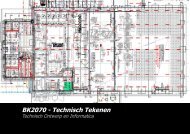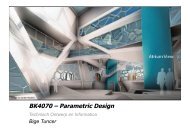Perception Aspects in Underground Spaces using ... - TOI - TU Delft
Perception Aspects in Underground Spaces using ... - TOI - TU Delft
Perception Aspects in Underground Spaces using ... - TOI - TU Delft
Create successful ePaper yourself
Turn your PDF publications into a flip-book with our unique Google optimized e-Paper software.
develop a generic method to model the <strong>in</strong>terrelationships. In that respect, it is of <strong>in</strong>terest to f<strong>in</strong>drelationships between ma<strong>in</strong> spatial characteristics of a built environment and the end user of thatenvironment. In that process, overlap between categories is <strong>in</strong>evitable, s<strong>in</strong>ce no sharp boundariesexist between categories.Architects and end users eventually communicate through space, s<strong>in</strong>ce one designs it, and theother experiences it. End users react differently to different spaces and may prefer one space tothe other with<strong>in</strong> the same social context. The <strong>in</strong>tention with this work is to try to capture thatcommunication. It is important to understand the position of both actors <strong>in</strong> that communicationprocess. The end user, accord<strong>in</strong>g to certa<strong>in</strong> stimuli, acts and reacts on the environment <strong>in</strong> respectto a specific time and social context. The architect tries to <strong>in</strong>tegrate <strong>in</strong> the design all requirementsand 'targets' the design for end users. That is the most desirable situation but as expla<strong>in</strong>ed earlier,there is a knowledge gap regard<strong>in</strong>g users perception of spaces. Therefore, it becomes a difficulttask for architects to <strong>in</strong>clude that <strong>in</strong> their design. In addition, constant changes with<strong>in</strong> societybr<strong>in</strong>g changes of requirements over time. In order to model the relationships between a builtenvironment and human be<strong>in</strong>gs, the knowledge from other discipl<strong>in</strong>es should be considered, suchas that from environmental psychology and sociology.2.7. A human be<strong>in</strong>g, built environment and social contextIn order to avoid ad-hoc design solutions there is a need for a systematic approach to design ofunderground spaces. In such a way an “<strong>in</strong>tuitive” approach to problem solv<strong>in</strong>g can be avoided(Bennett, 1977). It is important to note here that the study could be done from various viewpo<strong>in</strong>ts. One direction may come with more focus on social or economic issues and its reflectionon a built environment. Other po<strong>in</strong>ts of view could be to consider how various groups, forexample how different cultures or different societies perceive the built environment, as well ashow they <strong>in</strong>fluence changes <strong>in</strong> an environment. It is possible to imag<strong>in</strong>e various viewpo<strong>in</strong>ts. Forthis research, it was important to model the perception of people, liv<strong>in</strong>g <strong>in</strong> South Holland,regard<strong>in</strong>g underground spaces. In that respect, all users were considered as equal contributors tothe knowledge model s<strong>in</strong>ce they are a part of the same social context.The underground stations are relatively young structures. As a result, the <strong>in</strong>formation andknowledge relevant to underground spaces is rather few and scattered. Several authors stressedthe wide spread of <strong>in</strong>formation <strong>in</strong> environmental psychology that can be found <strong>in</strong> various journals(Mehrabian, 1976) yet state that such <strong>in</strong>formation is often fragmented, enclosed <strong>in</strong> statistics orexpressed <strong>in</strong> a type of language that is difficult to understand. It is also a fact that many f<strong>in</strong>d<strong>in</strong>gsare not published at all or are provided <strong>in</strong> a form of <strong>in</strong>ternal reports that are not accessible to thepublic (Cherulnik, 1993). Therefore, this private <strong>in</strong>formation is also not available for architectsand designers. An explanation could be simply due to requirements from a client to protect the<strong>in</strong>formation related to the project. Such discretion and confidentiality <strong>in</strong>evitably leads to thestagnation or slow progress <strong>in</strong> deepen<strong>in</strong>g knowledge.As for underground spaces, some psychological aspects deserved more attention than others, forexample orientation (Pass<strong>in</strong>i, 1984, 1992; Arthur, 1992; Galen, 1999), safety aspects (Korz,1998; Boer 1997; Galen, 1999) etc. Such research does provide valuable knowledge. They missthe relationship to other aspects, due to the limited <strong>in</strong>formation regard<strong>in</strong>g cause and effect. Thesewere exam<strong>in</strong>ed as isolated experiences, while experience of underground space depends on the- 19 -





